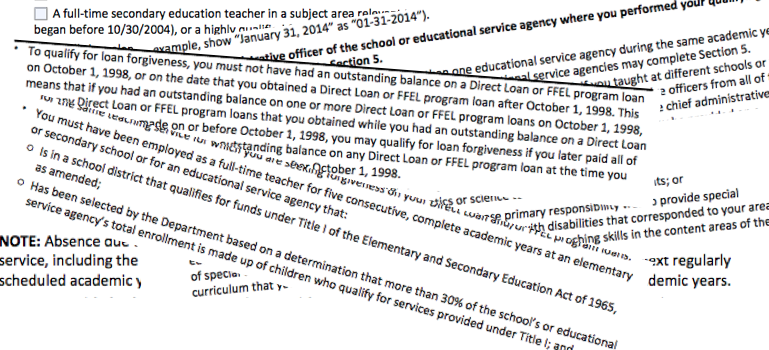Student Loans are Ripe for Behavioral Improvement
If you’re a teacher in the United States with a student loan, you can get $5,000 to $17,500 of your student loans forgiven by the federal government after five consecutive years of teaching in low-income schools. To do this, you’d have to first match the eligibility requirements to your position and your loans: If you took maternity leave does that year count? Does your loan count if you took a deferment while you got your Masters? This is detailed in an 8-page, 4,370 word application, linked towards the bottom of an FAQ page on the federal loan. Then you would have to figure out if your school is eligible during the past 5 years, which you’d need to search for on a separate page. Then, you would need to get a signature from someone at each school you worked at verifying that your employment was eligible during the time period that you were employed. Then, you would send it to your loan servicer and wait an unspecified amount of time to hear back if you received the loan forgiveness or didn’t. Then, finally, you aren’t guaranteed to receive a response.

There are many ways to improve this process that could make student loan repayment better. One way might be to make sure eligible teachers are aware that they are indeed eligible and from what jobs they were eligible. IPA has been working with researchers Brian Jacob, Damon Jones, and Ben Keys and the Michigan Department of Education to test how individualized informational mailings about this program affect loan forgiveness uptake (results are forthcoming). This project is partially motivated by the lack of knowledge about the program and individual eligibility among teachers. Only an estimated one percent of eligible teachers, including those without student loans, avail themselves of the program, so we can be assured the program is not currently working as intended. 1 A lack of knowledge is a likely culprit.
The complexity of this system makes it hard enough to use programs specifically designed to reduce student loan debt. But, this is only one example of how the system is poorly designed for borrowers. Much of this inefficient design is subtler than the loan forgiveness uptake problem. The conversation around problems like student debt and forgiveness is often from the perspective of hard numbers or structural factors—like the 1.4 trillion dollars in outstanding student debt. 1.4 trillion dollars is a mind-boggling, unimaginable, unintuitive amount. It makes for great headlines. When numbers like that are used, it often obscures the functional link in the middle—how do those structures affect and mediate behavior?
An example makes this more intuitive. Take Naomi, (a fictional example): She's a borrower who’s just taken a new job that increased her monthly after-tax salary from $1418.80 to $2231.76. Even though Naomi got a substantial raise, her monthly loan payment stays the same: $203. A more sensitive system would vary her payments, keeping them lower when she has less money, and making it up as she begins to make more. That system is called income-driven repayment (IDR). IDR plans often limit repayment to a certain percentage of income, and some offer loan forgiveness after a certain period of time. They benefit borrowers’ welfare the vast majority of the time, but borrowers must actively enroll, if they are even aware of IDR’s benefits.2 Most borrowers don’t.
[Income-driven Repayment Plans] benefit borrowers’ welfare the vast majority of the time, but borrowers must actively enroll, if they are even aware of IDR’s benefits.
In some sense this example illustrates a default problem. The default form of repayment has fixed, “mortgage-style” payments that don’t adjust for changes in borrower incomes. This makes the relative cost for borrowers highest at the exact time where incomes are lowest, and borrowers are least likely to have savings.3 Low uptake may be explained by the simple facts that borrowers may be uninformed and financial decision making is challenging even when perfect information is available.
However, lack of information is not the only inefficiency in loan repayment. In the loan forgiveness example at the start of this post, there are several mediating factors—availability of information, avoidance of stressful information, and structural problems such as oversight of loan servicers. Making sure that the right information is available when borrowers need to make decisions can ameliorate these.
The default form of repayment has fixed, “mortgage-style” payments that don’t adjust for changes in borrower incomes.
In this discussion, there is a tension between the huge structural problem of $1.4 trillion dollars of outstanding debt and these seemingly mundane informational and behavioral problems. The behavioral problems are ones that may be simple and cost-effective to address: a personalized letter costs 80 cents by my estimate. That letter won’t get rid of $1.4 trillion dollars of student loan debt, but it can improve stressed borrowers’ lives in a meaningful way.
Ultimately, education remains a good investment, and student loans allow students from lower wealth backgrounds to receive higher education at a higher rate. These benefits cannot be overstated. But inefficiencies in loan repayment increase costs for borrowers. Behavioral design can be an important tool to address the student loan repayment crisis. The first step is to make sure that existing programs are being utilized and used as they should, and then rigorously testing new solutions.
[1] Nowicki, J. (2015). Higher Education: Better Management of Federal Grant and Loan Forgiveness Programs for Teachers Needed to Improve Participant Outcomes. Report to Congressional Requesters. GAO-15-314. US Government Accountability Office. https://www.gao.gov/products/GAO-15-314
[2] Dynarski, Susan M., An Economist's Perspective on Student Loans in the United States (October 29, 2015). CESifo Working Paper Series No. 5579. Available at SSRN: https://ssrn.com/abstract=2694441
Chopra, R. (2013). Annual Report of the CFPB Student Loan Ombudsman. Report. US Consumer Financial Protection Bureau. https://files.consumerfinance.gov/f/201310_cfpb_student-loan-ombudsman-annual-report.pdf;
[3] Dynarski, S., & Kreisman, D. (2013). Loans for educational opportunity: Making borrowing work for today’s students. The Hamilton Project Discussion Paper, 5.











